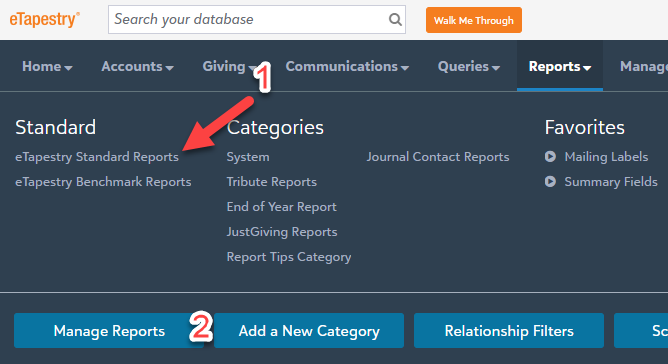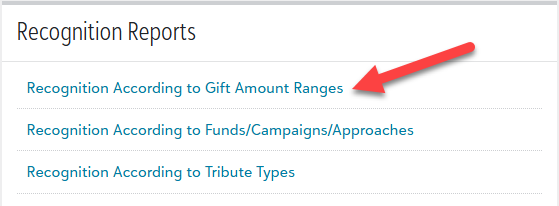Blackbaud eTapestry® Standard Reports: Organizing Donors in Giving Totals

Geoff Arbuckle
Blackbaud Employee








This is the third part of my short series highlighting some of my favorite eTapestry Standard Reports. For this final chapter (for now), let's talk about how you can organize donors into giving total groupings with the Recognition According to Gift Amount Ranges report.Often, organizations are able build reports, and then team members of those organizations use Excel to group donors into giving ranges. But what if I told you your team really didn't need to do a lot of work in Excel? What if eTapestry could provide you with a list of donors already organized when it comes out of eTapestry?
Why would this be useful? Well, not only can this save you time when analyzing your donors according to dollar ranges, but it will also help you display the information in a visually appealing way for publication or sharing with your board or Executive Director. That's where the eTapestry Standard Report for Recognition According to Gift Amount Ranges can come in handy.
My first blog in this series gave a little more background on the Standard Reports, but let's do a quick review how to get there. You will click Reports and choose one of the two options to access the eTapestry Standard Reports section:

This brings you to all the Standard Reports available to you. The second section on the left is labeled Recognition Reports, and that's where we'll find the Recognition According to Gift Amount Ranges report.

But... you may be wondering (and if you aren't, you might at some point): What does "recognition" mean in these reports? This refers to a very specific field found in two places. Whenever you create or edit an account or a gift entry, you have the ability to set a special "recognition" for the account as a whole or for very specific gifts.
This means if I were to donate to your organization, of course, by default, you would record my name as Geoff Arbuckle for tax and/or contact purposes. However, if I wanted to keep my very obvious and very real celebrity status somewhat less known when I was giving you large donations, you have the ability to enter either a pseudonym as my recognition, or list me as Anonymous, or even not recognize me at all in public reports.
The same can be the case for individual gifts. Generally speaking, I might regularly donate $100 to your organization. But let's say it just so happened that one week, I hit the lottery jackpot. So instead of the usual $100 gift, I make a $100,000 gift. If I want that specific gift to be listed as anonymous to protect my identity, you have the ability to enter that on the individual gift. So, these reports—which use the "Recognition" title—allow you to use these reports for public purposes. The system will automatically pull whatever recognition status was selected for accounts and gifts to list individuals.
Because this is a Standard Report, you are able to use basically any query in your system. All Constituents would look at everyone all time and list giving totals based on what they gave and the ranges you created. You could also create specific queries to find only the journal entries from a date range or from specific approaches or campaigns, etc.
After you select the query you wish to use, the next thing you'll do is set the criteria. In other words, the ranges you wish to use:

You can create as many ranges as you want. To create an upper range, all you have to do is fill in the Lower box and leave the Upper blank as shown in the example above.
Next, you'll select your Display Options. Do you want to include all the columns for Pledged, Received, and Raised? My suggestions would be to either choose Received or Raised.

You will be asked whether you would like to Display Group Totals; this just means that when you run the report and it categorizes donors into their proper ranges, it will also total each range for you.
When you run the report, it will group everyone into their ranges and each range will look something like this:

Once you've run it, you can export it directly from the bottom of the report to either Excel or PDF. The PDF should look fairly polished and ready for print or to be sent to your Board. Considering it will not display any other information than what was previously agreed upon as recognition for the donor, you could even confidently publish this information on your website or on location if you so desire.
In May, I have a webinar planned to talk a little more about the Standard Reports I highlighted here on the blog along with others. I definitely recommend you keep an eye out for it! Naturally, I also will be providing a follow-up "Ask the Expert" session so you can ask your questions about Standard Reports.
I hope these topics I have discussed over the last 10 days have given you inspiration to go into eTapestry Standard Reports and play around to see what information you can pull from them. I look forward to publishing more tips and tricks in future blogs as well as providing more eTapestry webinars in the future. Until then, keep on eTappin' on!
Why would this be useful? Well, not only can this save you time when analyzing your donors according to dollar ranges, but it will also help you display the information in a visually appealing way for publication or sharing with your board or Executive Director. That's where the eTapestry Standard Report for Recognition According to Gift Amount Ranges can come in handy.
My first blog in this series gave a little more background on the Standard Reports, but let's do a quick review how to get there. You will click Reports and choose one of the two options to access the eTapestry Standard Reports section:

This brings you to all the Standard Reports available to you. The second section on the left is labeled Recognition Reports, and that's where we'll find the Recognition According to Gift Amount Ranges report.

But... you may be wondering (and if you aren't, you might at some point): What does "recognition" mean in these reports? This refers to a very specific field found in two places. Whenever you create or edit an account or a gift entry, you have the ability to set a special "recognition" for the account as a whole or for very specific gifts.
This means if I were to donate to your organization, of course, by default, you would record my name as Geoff Arbuckle for tax and/or contact purposes. However, if I wanted to keep my very obvious and very real celebrity status somewhat less known when I was giving you large donations, you have the ability to enter either a pseudonym as my recognition, or list me as Anonymous, or even not recognize me at all in public reports.
The same can be the case for individual gifts. Generally speaking, I might regularly donate $100 to your organization. But let's say it just so happened that one week, I hit the lottery jackpot. So instead of the usual $100 gift, I make a $100,000 gift. If I want that specific gift to be listed as anonymous to protect my identity, you have the ability to enter that on the individual gift. So, these reports—which use the "Recognition" title—allow you to use these reports for public purposes. The system will automatically pull whatever recognition status was selected for accounts and gifts to list individuals.
Because this is a Standard Report, you are able to use basically any query in your system. All Constituents would look at everyone all time and list giving totals based on what they gave and the ranges you created. You could also create specific queries to find only the journal entries from a date range or from specific approaches or campaigns, etc.
After you select the query you wish to use, the next thing you'll do is set the criteria. In other words, the ranges you wish to use:

You can create as many ranges as you want. To create an upper range, all you have to do is fill in the Lower box and leave the Upper blank as shown in the example above.
Next, you'll select your Display Options. Do you want to include all the columns for Pledged, Received, and Raised? My suggestions would be to either choose Received or Raised.
- Received displays all the actual cash you've received through one-time gifts, recurring gifts, and pledge payments.
- Raised displays one-time gifts, recurring gifts, and pledge totals.

You will be asked whether you would like to Display Group Totals; this just means that when you run the report and it categorizes donors into their proper ranges, it will also total each range for you.
When you run the report, it will group everyone into their ranges and each range will look something like this:

Once you've run it, you can export it directly from the bottom of the report to either Excel or PDF. The PDF should look fairly polished and ready for print or to be sent to your Board. Considering it will not display any other information than what was previously agreed upon as recognition for the donor, you could even confidently publish this information on your website or on location if you so desire.
In May, I have a webinar planned to talk a little more about the Standard Reports I highlighted here on the blog along with others. I definitely recommend you keep an eye out for it! Naturally, I also will be providing a follow-up "Ask the Expert" session so you can ask your questions about Standard Reports.
I hope these topics I have discussed over the last 10 days have given you inspiration to go into eTapestry Standard Reports and play around to see what information you can pull from them. I look forward to publishing more tips and tricks in future blogs as well as providing more eTapestry webinars in the future. Until then, keep on eTappin' on!
3
Categories
- All Categories
- 6 Blackbaud Community Help
- 209 bbcon®
- 1.4K Blackbaud Altru®
- 394 Blackbaud Award Management™ and Blackbaud Stewardship Management™
- 1.1K Blackbaud CRM™ and Blackbaud Internet Solutions™
- 15 donorCentrics®
- 359 Blackbaud eTapestry®
- 2.5K Blackbaud Financial Edge NXT®
- 646 Blackbaud Grantmaking™
- 563 Blackbaud Education Management Solutions for Higher Education
- 3.2K Blackbaud Education Management Solutions for K-12 Schools
- 934 Blackbaud Luminate Online® and Blackbaud TeamRaiser®
- 84 JustGiving® from Blackbaud®
- 6.4K Blackbaud Raiser's Edge NXT®
- 3.7K SKY Developer
- 243 ResearchPoint™
- 118 Blackbaud Tuition Management™
- 165 Organizational Best Practices
- 238 The Tap (Just for Fun)
- 33 Blackbaud Community Challenges
- 28 PowerUp Challenges
- 3 (Open) Raiser's Edge NXT PowerUp Challenge: Product Update Briefing
- 3 (Closed) Raiser's Edge NXT PowerUp Challenge: Standard Reports+
- 3 (Closed) Raiser's Edge NXT PowerUp Challenge: Email Marketing
- 3 (Closed) Raiser's Edge NXT PowerUp Challenge: Gift Management
- 4 (Closed) Raiser's Edge NXT PowerUp Challenge: Event Management
- 3 (Closed) Raiser's Edge NXT PowerUp Challenge: Home Page
- 4 (Closed) Raiser's Edge NXT PowerUp Challenge: Standard Reports
- 4 (Closed) Raiser's Edge NXT PowerUp Challenge: Query
- 779 Community News
- 2.9K Jobs Board
- 53 Blackbaud SKY® Reporting Announcements
- 47 Blackbaud CRM Higher Ed Product Advisory Group (HE PAG)
- 19 Blackbaud CRM Product Advisory Group (BBCRM PAG)